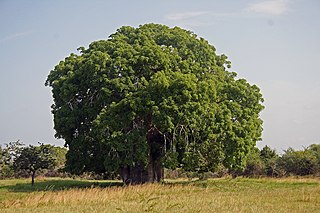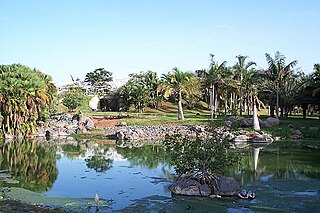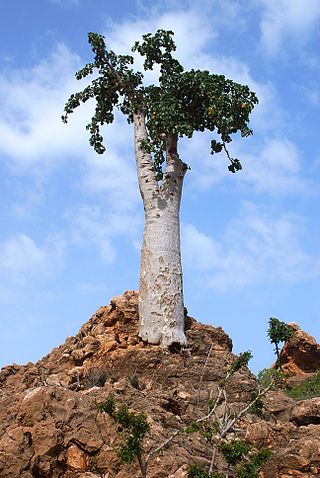
The Arecaceae is a family of perennial, flowering plants in the monocot order Arecales. Their growth form can be climbers, shrubs, tree-like and stemless plants, all commonly known as palms. Those having a tree-like form are called palm trees. Currently, 181 genera with around 2,600 species are known, most of which are restricted to tropical and subtropical climates. Most palms are distinguished by their large, compound, evergreen leaves, known as fronds, arranged at the top of an unbranched stem, except for the Hyphaene genus, who has branched palms. However, palms exhibit an enormous diversity in physical characteristics and inhabit nearly every type of habitat within their range, from rainforests to deserts.
The Cronquist system is a taxonomic classification system of flowering plants. It was developed by Arthur Cronquist in a series of monographs and texts, including The Evolution and Classification of Flowering Plants and An Integrated System of Classification of Flowering Plants (1981).

Adansonia is a genus made up of eight species of medium-to-large deciduous trees known as baobabs or adansonias. They are placed in the Malvaceae family, subfamily Bombacoideae. They are native to Madagascar, mainland Africa, and Australia. The trees have also been introduced to other regions such as Asia. A genomic and ecological analysis has suggested that the genus is Madagascan in origin.

A forb or phorb is an herbaceous flowering plant that is not a graminoid. The term is used in biology and in vegetation ecology, especially in relation to grasslands and understory. Typically these are dicots without woody stems.

Joseph Marie Henry Alfred Perrier de la Bâthie was a French botanist who specialized in the plants of Madagascar.

Adansonia gregorii, commonly known as the boab and also known by a number of other names, is a tree in the family Malvaceae, endemic to the northern regions of Western Australia and the Northern Territory of Australia.

Phytolacca dioica, commonly known as ombú in Spanish and umbu in Portuguese, is a massive evergreen tree in the Pokeweed Family (Phytolaccaceae) native to the Pampas of South America. As its specific epithet suggests, it is dioecious, with male and female flowers on separate plants. The flowers are pollinated by the butterfly Doxocopa laurentia. It has an umbrella-like canopy that spreads to a diameter of 12 to 15 meters and can attain a height of 12 to 18 meters. This upper growth springs up from a tuberous caudex which, according to Everett "may occupy a circle sixty feet [18 meters] in diameter". One tree of such a size is mentioned by Anglo-Argentine writer William Henry Hudson in his autobiography " Far Away and Long Ago", which was fifty feet girth above the caudex. Because it is derived from herbaceous ancestors, its trunk consists of anomalous secondary thickening rather than true wood. As a result, the ombú grows fast but its wood is soft and spongy enough to be cut with a knife. These properties have led it to be used in the art of bonsai, as it is easily manipulated to create the desired effect. Since the sap is poisonous, the ombú is not grazed by cattle and is immune to locusts and other pests. For similar reasons, the leaves are sometimes used as a laxative or purgative. It is a symbol of Uruguay, Rio Grande do Sul and Argentina, and of gaucho culture, as its canopy is quite distinguishable from afar and provides comfort and shelter from sun and rain.
A system of plant taxonomy, the Goldberg system was published in:

Adansonia digitata, the African baobab, is the most widespread tree species of the genus Adansonia, the baobabs, and is native to the African continent and the southern Arabian Peninsula. These are long-lived pachycauls; radiocarbon dating has shown some individuals to be over 2,000 years old. They are typically found in dry, hot savannas of sub-Saharan Africa, where they dominate the landscape and reveal the presence of a watercourse from afar. They have traditionally been valued as sources of food, water, health remedies or places of shelter and are a key food source for many animals. They are steeped in legend and superstition. In recent years, many of the largest, oldest trees have died, for unknown reasons. Common names for the baobab include monkey-bread tree, upside-down tree, and cream of tartar tree.

Adenium obesum, more commonly known as a desert rose, is a poisonous species of flowering plant belonging to the tribe Nerieae of the subfamily Apocynoideae of the dogbane family, Apocynaceae. It is native to the Sahel regions south of the Sahara, tropical and subtropical eastern and southern Africa, as well as the Arabian Peninsula. Other names for the flower include Sabi star, kudu, mock azalea, and impala lily. Adenium obesum is a popular houseplant and bonsai in temperate regions.

Adansonia madagascariensis or Madagascar baobab is a small to large deciduous tree in the family Malvaceae. It is one of six species of baobab endemic to Madagascar, where it occurs in the Madagascar dry deciduous forests.

Borassus aethiopum is a species of Borassus palm from Africa. In English, it is variously referred to as African fan palm, African palmyra palm, deleb palm, ron palm, toddy palm, black rhun palm, rônier palm. It is widespread across much of tropical Africa from Senegal to Ethiopia and south to northern South Africa, though it is largely absent from the forested areas of Central Africa and desert regions such as the Sahara and Namib. This palm also grows in northwest Madagascar and the Comoros.

The Palmetum of Santa Cruz de Tenerife is a botanical garden of 120,000 m2 specialized in palms (Arecaceae). It is an artificial hill, with views of the ocean, located in Santa Cruz de Tenerife, Canary Islands, Spain. The gardens include a large system of waterfalls, streams and ponds, a museum dedicated to palms, and a display shade house. The project was started in 1995 on a former landfill and only opened to the public in 2014. The valuable palm collection gathers about 600 species of palms and it is focused on the ones native to world islands. Trees and shrubs of other plant families are also displayed, organised in "biogeographical sections". All gardens are maintained with no pesticides and no fertilizers, different species of wild birds are easily seen in the palmetum.

Adansonia grandidieri is the biggest and most famous of Madagascar's six species of baobabs. It is sometimes known as Grandidier's baobab or the giant baobab. In French it is called Baobab malgache. The local name is renala or reniala. This tree is endemic to the island of Madagascar, where it is an endangered species threatened by the encroachment of agricultural land. This is the tree found at the Avenue of the Baobabs.

Adansonia za is a species of baobab in the genus Adansonia of the family Malvaceae. It was originally named in French as anadzahé. Common names in Malagasy include bojy, boringy, bozy, bozybe, ringy, and za, the last of which gives the plant its specific epithet. Eight Adansonia species are recognized, with six endemic to Madagascar. Adansonia za is the most widespread of the Madagascar endemics.
The Melchior system, "a reference in all taxonomic courses", is a classification system detailing the taxonomic system of the Angiospermae according to A. Engler's Syllabus der Pflanzenfamilien (1964), also known as "modified or updated" Engler system.

In botany, succulent plants, also known as succulents, are plants with parts that are thickened, fleshy, and engorged, usually to retain water in arid climates or soil conditions. The word succulent comes from the Latin word sucus, meaning "juice" or "sap".

Dendrosicyos is a monotypic genus in the plant family Cucurbitaceae. The only species is Dendrosicyos socotranus, the cucumber tree. The species is endemic to the island of Socotra in Yemen, and is the only species in the Cucurbitaceae to grow in a tree form. The species name was originally spelled D. socotrana, but this is corrected to masculine grammatical gender according to the International Code of Nomenclature for algae, fungi, and plants.

Sunland Baobab is a well-known enormous baobab in South Africa. The tree is located on Sunland Farm, near Modjadjiskloof, Limpopo Province. In one study the tree was carbon-dated and found to be an estimated 1,060 years old, plus or minus 75 years. Results of other studies have however suggested much higher ages. The tree used to bloom profusely in spring, at some stage providing a refuge to two pairs of owls, and other bird species. Most of the tree died in 2016 and 2017.
















